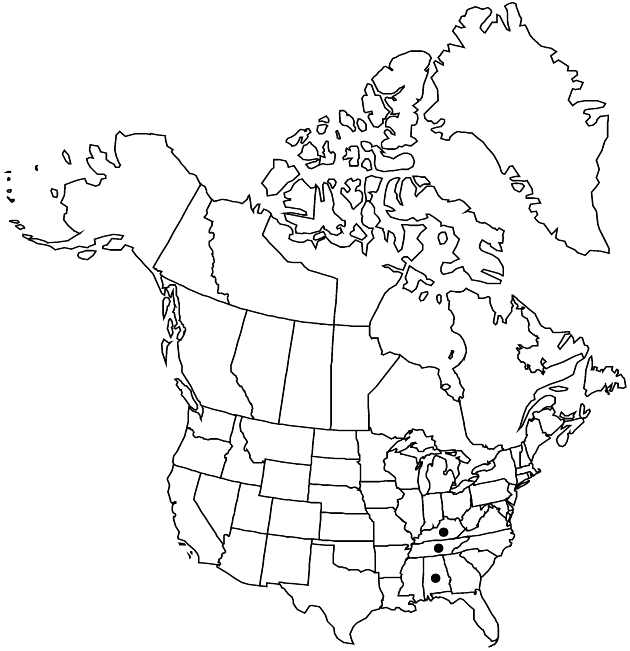Difference between revisions of "Helianthus eggertii"
Fl. S.E. U.S., 1267, 1340. 1903.
FNA>Volume Importer |
FNA>Volume Importer |
||
| Line 24: | Line 24: | ||
|elevation=100–300 m | |elevation=100–300 m | ||
|distribution=Ala.;Ky.;Tenn. | |distribution=Ala.;Ky.;Tenn. | ||
| − | |discussion=<p>Helianthus eggertii is similar to H. strumosus and H. laevigatus; it is distinguished by the distinctive blue coloration of stems and leaves and by the leaves usually 1-nerved, in contrast to the 3-nerved condition typical for the genus. It is listed federally as an endangered species; R. L. Jones (1994) found it to be more common than was previously thought, and it is now in the process of being removed from the federal list.</p><!-- | + | |discussion=<p><i>Helianthus eggertii</i> is similar to <i>H. strumosus</i> and <i>H. laevigatus</i>; it is distinguished by the distinctive blue coloration of stems and leaves and by the leaves usually 1-nerved, in contrast to the 3-nerved condition typical for the genus. It is listed federally as an endangered species; R. L. Jones (1994) found it to be more common than was previously thought, and it is now in the process of being removed from the federal list.</p><!-- |
--><p>of conservation concern</p> | --><p>of conservation concern</p> | ||
|tables= | |tables= | ||
| Line 49: | Line 49: | ||
|publication year=1903 | |publication year=1903 | ||
|special status= | |special status= | ||
| − | |source xml=https://jpend@bitbucket.org/aafc-mbb/fna-data-curation.git/src/ | + | |source xml=https://jpend@bitbucket.org/aafc-mbb/fna-data-curation.git/src/8f726806613d60c220dc4493de13607dd3150896/coarse_grained_fna_xml/V19-20-21/V21_379.xml |
|tribe=Asteraceae tribe Heliantheae | |tribe=Asteraceae tribe Heliantheae | ||
|subtribe=Asteraceae (tribe Heliantheae) subtribe Helianthinae | |subtribe=Asteraceae (tribe Heliantheae) subtribe Helianthinae | ||
Revision as of 16:34, 18 September 2019
Perennials, 30–200+ dm (rhizomatous). Stems erect, glabrous (distinctively bluish, glacous). Leaves cauline; all or mostly opposite; sessile; blades (1-nerved) lanceolate to lance-ovate, 7–16.5 × 1.5–3.5 cm, bases cuneate, margins entire or serrulate, faces glabrous (abaxial) or strumose (adaxial), gland-dotted. Heads 1–5. Peduncles 1–4 cm. Involucres hemispheric, 10–25 mm diam. Phyllaries 30–38, lanceolate, 12–16 × 3.5–4.5 mm, (margins ciliate) apices acuminate, abaxial faces glabrate, not gland-dotted. Paleae 9–11 mm, entire or ± 3-toothed (apices deltate). Ray florets 10–18; laminae 15–20 mm. Disc florets 70+; corollas 5–7 mm, lobes yellow; anthers dark, appendages dark or ± yellowish. Cypselae 4–6 mm, glabrous; pappi of 2 aristate scales 3–4 mm plus 0–1 deltate scales 0.5–1 mm. 2n = 102.
Phenology: Flowering late summer–fall.
Habitat: Open barrens, open oak-hickory woodlands
Elevation: 100–300 m
Distribution

Ala., Ky., Tenn.
Discussion
Helianthus eggertii is similar to H. strumosus and H. laevigatus; it is distinguished by the distinctive blue coloration of stems and leaves and by the leaves usually 1-nerved, in contrast to the 3-nerved condition typical for the genus. It is listed federally as an endangered species; R. L. Jones (1994) found it to be more common than was previously thought, and it is now in the process of being removed from the federal list.
of conservation concern
Selected References
None.